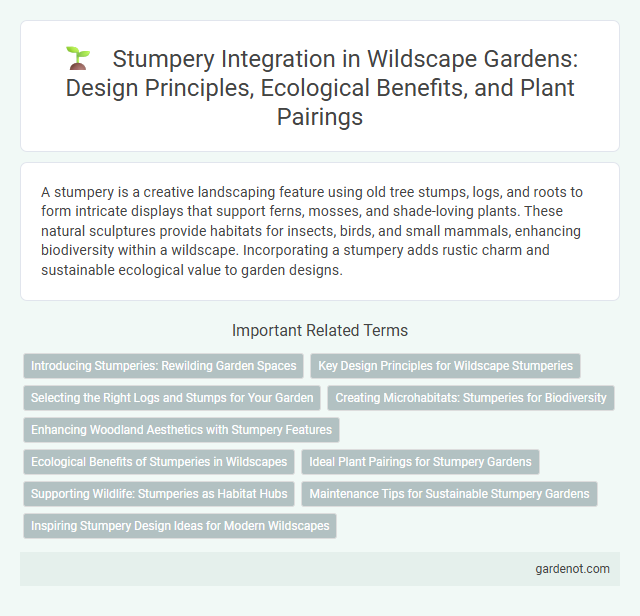A stumpery is a creative landscaping feature using old tree stumps, logs, and roots to form intricate displays that support ferns, mosses, and shade-loving plants. These natural sculptures provide habitats for insects, birds, and small mammals, enhancing biodiversity within a wildscape. Incorporating a stumpery adds rustic charm and sustainable ecological value to garden designs.
Introducing Stumperies: Rewilding Garden Spaces
Stumperies transform garden spaces by repurposing tree stumps and roots to create naturalistic habitats that promote biodiversity and support local wildlife. These rewilding garden features mimic woodland environments, fostering mosses, ferns, and fungi that enhance soil health and ecosystem resilience. Incorporating stumperies in wildscape designs encourages sustainable gardening practices while enriching urban and suburban green spaces.
Key Design Principles for Wildscape Stumperies
Wildscape stumperies emphasize naturalistic design by arranging tree stumps and logs to mimic native woodland ecosystems, promoting biodiversity and habitat creation for insects, birds, and small mammals. Key design principles include using locally sourced timber to ensure ecological harmony, incorporating varied textures and heights to support diverse fauna, and fostering damp, shaded microenvironments ideal for ferns and mosses. This approach enhances ecological connectivity and sustainable woodland management within wild landscapes.
Selecting the Right Logs and Stumps for Your Garden
Choosing the right logs and stumps for your wildscape garden involves selecting native hardwood species such as oak, maple, or beech that resist decay and support local wildlife. Opt for logs with varied diameters and partially decayed wood to encourage fungi growth, insects, and small mammals, enhancing biodiversity. Position stumps in shaded, moist areas to create ideal microhabitats for mosses, ferns, and invertebrates crucial to a thriving wildscape ecosystem.
Creating Microhabitats: Stumperies for Biodiversity
Stumperies, constructed from decaying tree stumps and logs, create essential microhabitats that support diverse wildlife and promote biodiversity within Wildscape environments. These structures provide shelter for insects, amphibians, and fungi, fostering complex ecological interactions that enhance soil health and plant growth. Integrating stumperies into habitat restoration projects encourages native species proliferation and strengthens ecosystem resilience.
Enhancing Woodland Aesthetics with Stumpery Features
Stumpery features enhance woodland aesthetics by creatively incorporating tree stumps, roots, and logs to create naturalistic garden structures that blend seamlessly into forest environments. These installations support biodiversity by providing habitats for fungi, insects, and small wildlife, enriching the woodland ecosystem. Integrating stumperies within wildscapes elevates the visual complexity and ecological value of woodland gardens.
Ecological Benefits of Stumperies in Wildscapes
Stumperies in wildscapes provide critical habitats for diverse wildlife, including amphibians, insects, and fungi, promoting biodiversity and ecosystem resilience. They enhance soil health by facilitating natural decomposition and nutrient cycling through decaying wood materials. By mimicking natural forest floor environments, stumperies improve moisture retention and support pollinator populations essential for plant reproduction.
Ideal Plant Pairings for Stumpery Gardens
Ferns, hostas, and hellebores thrive in stumpery gardens by complementing the rich textures of rotting wood and shaded environments. Woodland bulbs such as bluebells and snowdrops enhance seasonal interest while supporting the moist, nutrient-rich soil conditions ideal for stumperies. Incorporating mosses and shade-loving shrubs like rhododendrons creates layered biodiversity and naturalistic appeal in stumpery landscapes.
Supporting Wildlife: Stumperies as Habitat Hubs
Stumperies provide essential habitats for a variety of wildlife, offering shelter and breeding sites for insects, amphibians, and small mammals. Their intricate network of decaying wood and dense foliage creates a microenvironment that supports biodiversity and promotes ecological balance. By integrating stumperies into wildscapes, ecosystems benefit from increased species richness and enhanced natural resilience.
Maintenance Tips for Sustainable Stumpery Gardens
Regularly removing invasive weeds and monitoring moisture levels ensures healthy root systems in stumpery gardens. Applying organic mulch around stumps retains soil moisture and reduces erosion while promoting beneficial microbial activity. Seasonal inspections for decay or pest infestations help maintain structural integrity and encourage sustainable growth in wildscape environments.
Inspiring Stumpery Design Ideas for Modern Wildscapes
Inspiring stumpery design ideas for modern wildscapes blend natural decay with artistic creativity to create unique garden features that promote biodiversity. Utilizing moss-covered tree stumps, ferns, and shade-loving plants within layered wood arrangements transforms neglected woodland debris into vibrant habitats for insects and small wildlife. Integrating rustic textures alongside native plant species enhances the ecological function and aesthetic appeal of contemporary wildscape designs.
Stumpery Infographic

 gardenot.com
gardenot.com